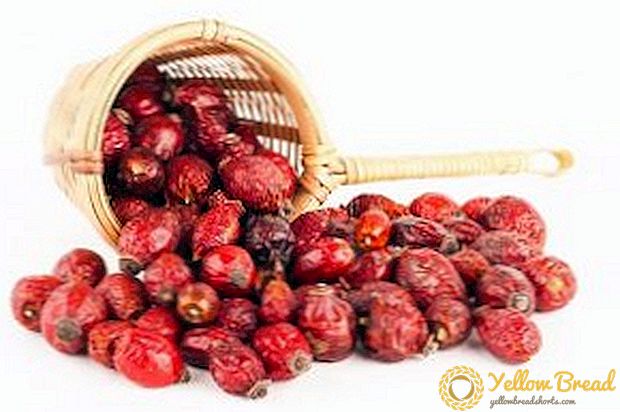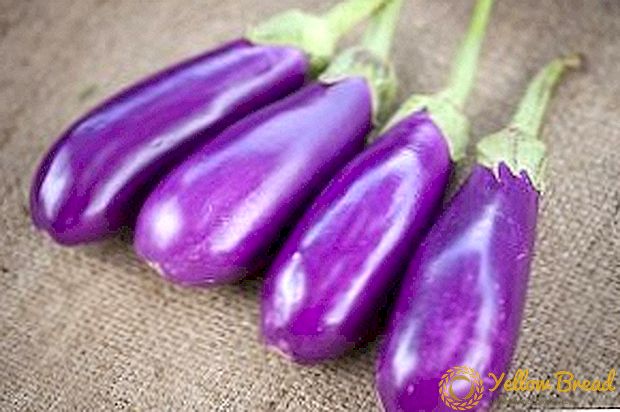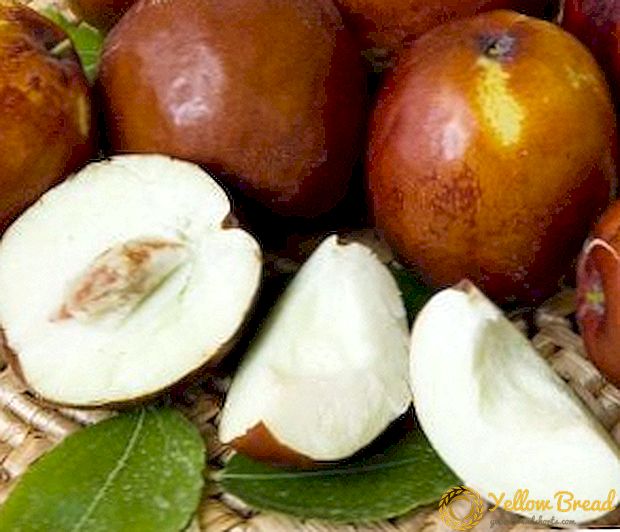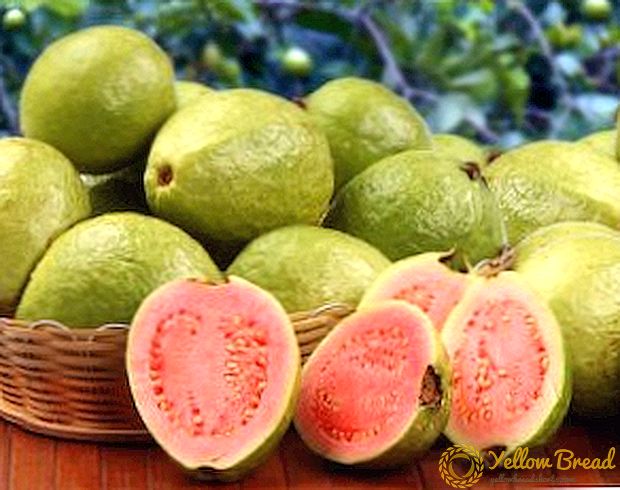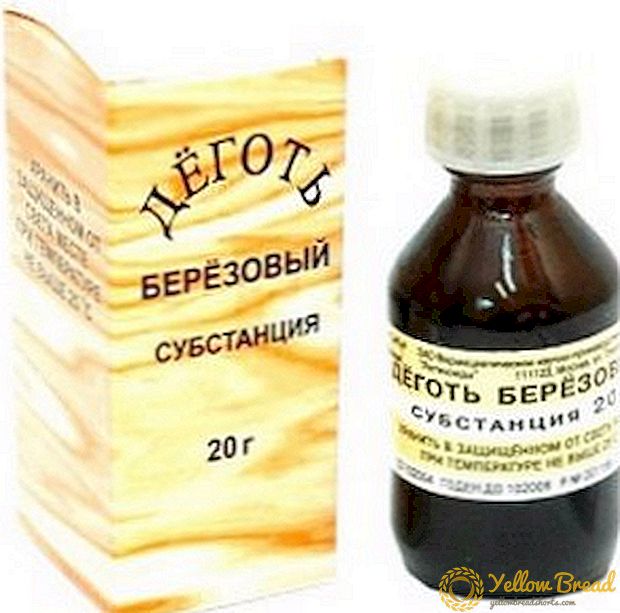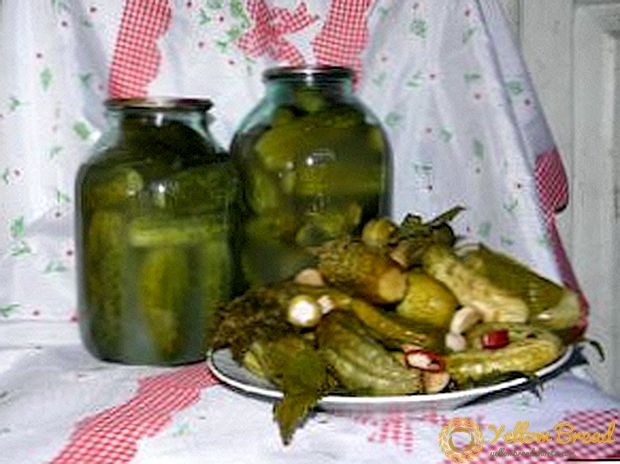
Without pickled cucumbers you can not imagine a Russian feast. They are used as an independent snack to potatoes, buckwheat, salted fish and strong alcohol, or add various dishes.
They deserve their popularity due to the unique taste, low cost and extreme ease of cooking at home. How to choose delicious pickles for the leaven, how to prepare and save them in the future, we will tell in our article. It will also be interesting to watch a useful video on this topic.
What it is?
The process of pickling cucumbers is as follows:
- Pre-soaked cucumbers together with spices are placed in a clean container and poured with brine.
- In brine and fruits, lactic acid, acetic acid, butyric acid and yeast bacteria begin to actively develop, which start the fermentation process.
- During the fermentation of sugar in cucumbers, of them in large quantities produced natural preservative called lactic acid. It stops or inhibits the vital activity of putrefactive bacteria and mold, which lead to the deterioration of vegetables.
Under the influence of these factors, cucumbers are preserved, acquiring special taste, a specific smell and a long shelf life.
How to choose a vegetable?
As a result of centuries-old selection, about 200 varieties of cucumbers were bred. and not all of them are suitable for fermentation. In order to select a suitable vegetable among them, it is necessary to adhere to such criteria.
 The optimal size of cucumber varies from 9 to 12 centimeters. Fruits at this stage of ripening contain a large amount of sugar and lactic acid, which are necessary for high-quality fermentation.
The optimal size of cucumber varies from 9 to 12 centimeters. Fruits at this stage of ripening contain a large amount of sugar and lactic acid, which are necessary for high-quality fermentation.
Over-grown cucumbers are undesirable to use, since air filled with voids is often formed inside such fruits. Due to excess air, the fermentation process in the fruit is uneven, and the cucumber becomes very soft.
The color of the leavening cucumber should be dark green., preferably with bright tips or white stripes on the sides. Varieties with such external data ferment the fastest. But if there were no such cucumbers, others will come down, the main thing is that their color should not be yellow.
It is necessary to choose cucumbers with thin skin and black pimples, since such a skin contributes to the uniform and rapid absorption of brine into the fetus. Poor absorption of the liquid leads to the fact that sugar,contained in the fruit, begins to ferment, but since decay products are not released to the outside, the cucumber acquires a bitter taste and an unpleasant aroma.
Some supermarket cucumbers may be paraffin-coated to increase shelf life and give them a glossy shine. Paraffin dissolved in brine may cause indigestion.
Watch a video about pickling cucumbers for pickling:
Preservation methods and their differences
To understand the differences between pickling, pickling and pickling cucumbers, each of these processes should be considered in more detail.
To boil
Pickled cucumbers are preserved by lactic acidwhich is formed as a result of fermentation of fruits in a salt solution. This method of preservation allows to partially preserve the cucumber taste and smell.
Salting
Salted cucumbers intended for storage in an apartment differ from fermented so that they are preserved, mainly due to the large amount of salt, and lactic acid in this process has a supporting role. The salt content in the salting solution is from 3 to 5%, and for souring from 1.5 to 2.5%. There are also significant differences in the level of acidity.
Pickling
In this case, cucumbers are prepared in marinade: boiled solution of water, salt, sugar and vinegar. Boiling water with acetic acid destroys bacteria, leading to rotting cucumber, and with them most of the beneficial vitamins and trace elements contained in the fruit.
In the barrel and in the bank - what's the difference?
The differences between the two types of yeast are:
- when souring the barrel for the winter, it is necessary to ferment and store cucumbers in a barrel or a metal container in a dark and cool place;
- with a canned storage method, cucumbers are first fermented, and then rolled up on cans and closed with plastic lids.
Closed lid canned cucumbers are stored a little longer than cask.
The taste of barrel and canned cucumbers, as a rule, the same, if the technology of preparation and storage of fruits was not violated, and the fruits themselves were correctly selected according to the type of peel and size.
Benefit and harm
Lactic acid and some other vitamins and trace elements that are contained in fermented cucumbers have a positive effect on the body:
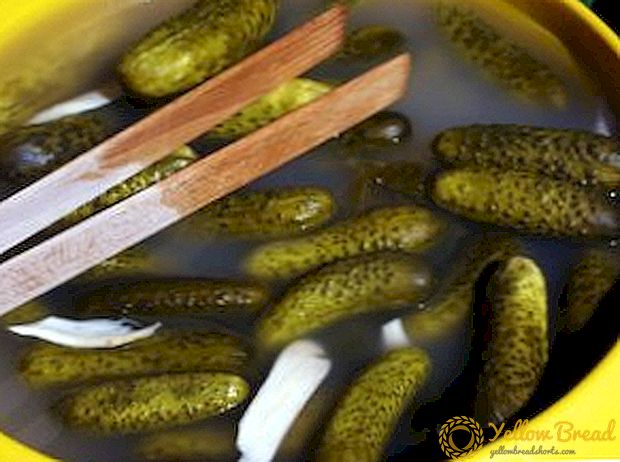 Stimulate the development of beneficial bacteria in the intestine.
Stimulate the development of beneficial bacteria in the intestine.- Improve the secretion of gastric juice.
- Give a slight laxative effect.
- Relieve hangover syndrome (especially when using brine).
The use of pickled cucumbers is not recommended in the presence of such diseases and pathologies:
- cholelithiasis;
- hypertension;
- atherosclerosis;
- pyelonephritis;
- second degree obesity;
- kidney disease.
Watch the video about the benefits and dangers of pickled cucumbers:
Calorie and Vitamins
The average calorie content in one cucumber from a jar of pickled cucumbers is 11.2 kilocalories.. Vitamin and mineral composition of this product is as follows:
- potassium;
- phosphorus;
- magnesium;
- calcium;
- zinc;
- iron;
- vitamins of groups C, B, PP.
Cold salting
The recipe, how to cook for the winter fermented, as well as crispy, like barrel-shaped cucumbers without sterilization, in cold cans. This technology of salting does not require boiling brine, as well as thorough disinfection of cans and their subsequent seaming.
For cooking will need:
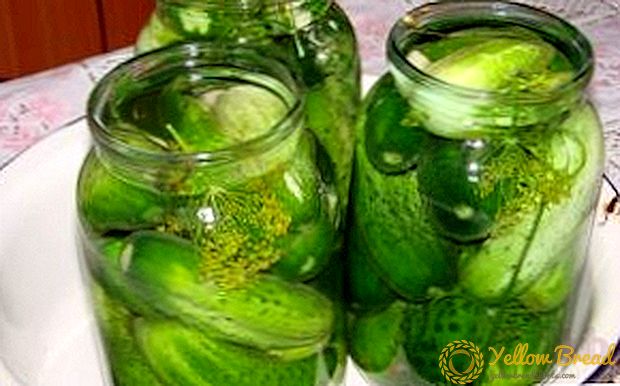 well washed cans;
well washed cans;- 3-4 pieces umbrella dill;
- 2-3 pieces horseradish leaves;
- 5-7 pcs.cherry or currant leaves;
- 4 cloves of garlic;
- red or black pepper peas (to taste);
- 3 tablespoons of salt;
- 1 cup of warm water;
- capacity for soaking cucumbers;
- the right amount of filtered water.
It is strongly not recommended to soak and ferment cucumbers in tap water, because it is too hard because of its high content of lime and other harmful substances. This will adversely affect the taste of the fermented product.
Sequencing:
- Before salting cucumbers should be soaked in clean water for several hours. This will allow them to collect the right amount of moisture so that they do not absorb water from the can, reducing its amount.
- Before soaking, it is recommended to cut off the tips of cucumbers, because it contains the greatest amount of nitrates.
- Next, cucumbers are vertically stacked in cleanly washed and preferably scalded banks with boiling water, where vegetables alternate with spices. Also, spices can simply fall asleep at the bottom of the jar, before laying cucumbers.
- Then prepare the brine. To do this, pour salt into a glass and pour warm water there, stirring it untiluntil the crystals completely dissolve.
- The resulting brine is poured into the jar.
- After the brine bank is filled with clean water to the top. So that the water layer closes the tips of the top layer of cucumbers, which will save them from withering, rotting and mildew.
Watch the video about the cold method of pickling cucumbers:
Slices
If you need a recipe for cooking pickled cucumbers immediately ready to serve or to add to the dishes, then this recipe for cucumbers slices. It is for him that it is recommended to pickle too big, thick-skinned and over-ripe cucumbers, which, as a whole, do not ferment badly.
To prepare 4 kg of cucumbers will need:
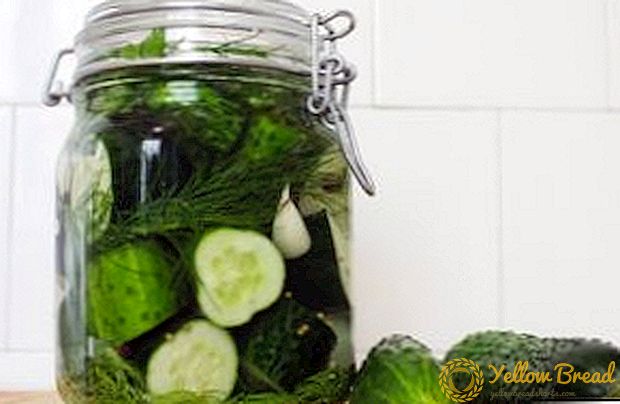 liter or half-liter jars with a screw lid (such jars do not need to be rolled up);
liter or half-liter jars with a screw lid (such jars do not need to be rolled up);- screw caps to the banks;
- 250 g of sugar;
- 200-250 g of 9% vinegar, which is necessary so that the circles do not soften, retain their density and crackle;
- 1 cup of refined sunflower oil;
- 1 ring of bitter pepper;
- 1 tablespoon ground pepper mixture;
- 2 tablespoons of salt;
- 3 heads of garlic;
- beaker;
- capacity for cooking marinade;
- large metal basin or large cooking pot;
- a circle for sterilizing cans;
- saucepan to the size of the circle;
- the right amount of filtered water.
Procedure:
- Cucumbers with cut tips are thoroughly washed, and then, at least 2 hours soaked in clean water. After soaking the vegetables, they are cut into slices, peppers are sprinkled on them, and garlic is squeezed out.
- In the tank, marinade is prepared from vinegar, sunflower oil, sugar and salt, which are stirred until completely dissolved.
- Cucumbers poured marinade and put in a cold place for 5-7 hours.
- When cucumbers are pickled, banks should be sterilized. To do this, put a saucepan on the stove on the stove, bring it to a boil and place a circle for sterilization on top, but do not put out the fire. The bank is installed on this circle with its neck down and lasts 10 minutes. Hot steam coming in will kill most microorganisms.They can also be sterilized by keeping 10 minutes in the oven at 160 degrees or in a microwave oven at a power of 700-800 watts. Sterilized jars are placed in a clean place in the kitchen.
- The lids are also sterilized; for this purpose they are boiled for a few minutes in water, and then they are laid to lie just in hot water. Hot water is necessary for the lid to expand, which will make it easier to screw in and then seal the can when it is cooled (the lid will taper and tightly grip the neck).
- On banks, cucumbers are laid out, which are poured with marinade, but not to the neck, but a centimeter before it.
- A large basin or pan is placed on the stove, a towel is placed on its bottom, and jars of cucumbers on a towel. The space between them is better to put gauze or HB towel so that the banks do not touch each other side. Then water is poured into the tank, which should reach the “hangers” of the cans. It is brought to a boil and kept in this state for 10 minutes, until the jars and their contents are sterilized again.
- After sterilization, the jar is tightly screwed onto the lid and turned upside down several times to allow the brine to wet the top of the cucumbers.
With aspirin
For cooking will need:
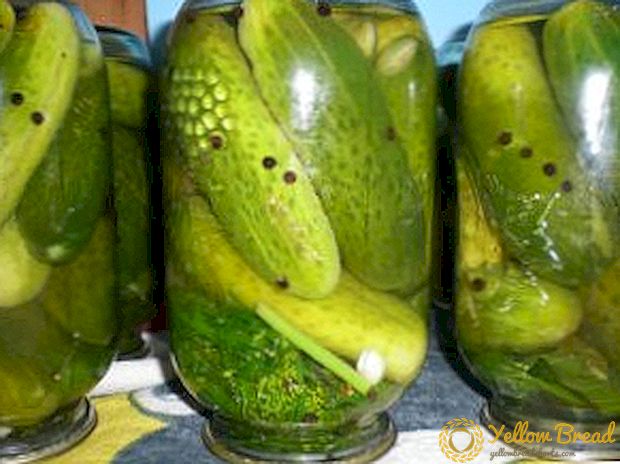 three-liter cans with a screw cap;
three-liter cans with a screw cap;- dill umbrella;
- 8 cloves of garlic;
- 6 bay leaves;
- 3-4 peppercorns;
- 2-4 pea carnations;
- 3 tablespoons of salt;
- 1 tablespoon of sugar;
- 1 tablespoon of vinegar;
- 2 aspirin tablets;
- pan for boiling brine;
- a circle for sterilizing cans;
- capacity for soaking cucumbers;
- blankets and warm clothes.
Procedure:
- Cucumbers are washed and soaked for several hours.
- Banks and covers to them are sterilized in one of the ways described above.
- Cucumbers and spices are laid in a sterilized jar, poured with salt on top and poured with cold water, then closed and left to wander for a day.
- A day later, the brine obtained in this way is poured from the jar into the pan, where sugar is added to it. The mixture is brought to a boil and boils for 2-3 minutes.
- In a jar of cucumbers put 2 aspirin tablets, then pour it with boiling brine almost to the top, leaving a little space for a spoonful of vinegar, which is added to the very end. Then the can is twisted with a sterilized cap extracted from warm water.
- Hot cans for a day and a half are tightly covered and lined with warm clothes so that the heat in them lasts as long as possible and kills all the microorganisms inside. When they finally cool, they can be put on long-term storage.
Watch a video on pickling (pickling) cucumbers with aspirin:
Supplements
You can preserve different types of vegetables with cucumbers.:
- tomatoes;
- zucchini;
- Bulgarian pepper;
- carrot;
- cauliflower;
- onion.
The list of inventory and ingredients, as well as the sequence of actions to create a platter with vegetables, are identical to those described in the recipe about cucumbers in slices.
How to get a crunch?
To pickled cucumbers turned out crispy, you need to choose the right variety before salting. They must be of an appropriate size, with a thin but durable skin and dark-colored pimples. The longer the fruits will be soaked before souring, the better the result will be. Crunch is also facilitated by pickling with vinegar and adding vodka, horseradish and oak leaves to the pickle.
How to extend the shelf life?
 To pickled cucumbers longer stored, you should keep them in the dark and cold. To prevent mold it is not recommended to add currant leaves to cucumbers. To get cucumbers from an open barrel or uncorked can, you need to sterilized with a fork treated with boiling water, and constantly close the can with a nylon so that the brine does not ferment. It is also necessary to periodically remove the mold film and deal with its occurrence with mustard powder or sprinkling brine with horseradish chips.
To pickled cucumbers longer stored, you should keep them in the dark and cold. To prevent mold it is not recommended to add currant leaves to cucumbers. To get cucumbers from an open barrel or uncorked can, you need to sterilized with a fork treated with boiling water, and constantly close the can with a nylon so that the brine does not ferment. It is also necessary to periodically remove the mold film and deal with its occurrence with mustard powder or sprinkling brine with horseradish chips.
If not enough salt has been added to the starter, cucumbers can disappear or get an unpleasant taste. The same will happen under improper storage conditions. Also, during storage of pickled cucumbers, mold may appear on the brine surface, which will give the product an unpleasant taste and odor.
How and where to store?
It is necessary to store fermented vegetables in a dark and cold place so that the sun's rays and high temperatures do not spur the fermentation process in brine. Such places are: cellar, basement, refrigerator, balcony, pantry, as well as rarely opening cabinets, which are located away from heating devices.
Dishes
They can be added to the vinaigrette, the legendary New Year’s “Olivier” salad, they can be supplemented with vegetable salads, or cooked with pickled pickles. In total there are about 300 recipes where pickles are used.
How else can you make blanks for the winter?
To preserve cucumbers for the winter, in addition to salting, you can resort to such methods:
- put them in a sealed container, pump out the air from there and store them in a refrigerator or pantry;
- coat with egg white and put in the fridge.
They can also be cut into circles, cubes or straws and frozen in a freezer.
Conclusion
With the help of fermentation, you can quickly and effortlessly prepare a large number of cucumbers for the winter. If you exactly follow the recipe and comply with storage conditions, pickled vegetables in the fall will delight your taste until the beginning of next summer.

 Stimulate the development of beneficial bacteria in the intestine.
Stimulate the development of beneficial bacteria in the intestine. well washed cans;
well washed cans; liter or half-liter jars with a screw lid (such jars do not need to be rolled up);
liter or half-liter jars with a screw lid (such jars do not need to be rolled up); three-liter cans with a screw cap;
three-liter cans with a screw cap;